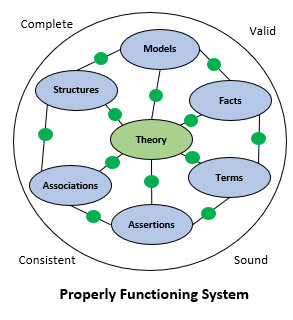Global Standard Machine-Readable Logic Framework for Business
My testing of XBRL-based digital financial reports has lead me to the point where it is pretty obvious that there would be great benefits to business if there were a global standard machine-readable logic framework for business.
This is what I mean. There are many domains that use logic. Philosophers invented logic and tend to use propositional logic, electrical engineers use logic gates to design electronic circuit, designers of complex systems like nuclear power plants use Z-notation, computer scientists use predicate logic which is an extension of propositional logic, etc.
But why does business not really have a logic framework? Perhaps it is not a fair or even appropriate comparison. But it might be. Business professionals use electronic spreadsheets for solving all sorts of problems. The electronic spreadsheet is more of a presentation-oriented (sheet, column, row) modeling tool as contrast to a logic modeling tool.
Let us suppose that business professionals needed some sort of logic modeling tool. What terminology might that tool use? There is no real standard terminology for working with logic that I have seen. However, the terminology can be created. If I were to create standard terminology, the terms would be: theory, model, structure, term, association, assertion, and fact. These are all statements. All these statements need to be complete, valid, consistent, and sound. The system needs to be fully expressed. Graphically, I created the following depiction: (here are the definitions of the terms used)

Now, this graphic communicates an idea, not a logical thing that can be measured. I would like to come up with a better graphic.
Think of this as a complete set of statements that have to be consistent and everything has to be valid and if you achieve this then the system is sound. If all those four constraints are met and the system is fully expressed, then the system is functioning properly. Two different people can look at the same set of statements and reach the same conclusion.
What is more, you can prove that the system is functioning properly, the full set of statements is like a “parity check” or a “check sum”.
I see this as having similarities to the double-entry accounting system.
Single-entry accounting is how 'everyone' would do accounting. In fact, that is how accounting was done before double-entry accounting was invented. Double-entry accounting adds an additional important property to the accounting system, that of a clear strategy to identify errors and to remove the errors from the system. Even better, double-entry accounting has a side effect of clearly firewalling errors as either accident or fraud. This then leads to an audit strategy. Double-entry accounting is how professional accountants do accounting. Double-entry accounting was the invention of medieval merchants and was first documented by the Italian mathematician and Franciscan Friar Luca Pacioli.
Double-entry accounting is one of the greatest discoveries of commerce and its significance is difficult to overstate. Which came first, double-entry accounting or the enterprise? Was it double-entry accounting and what it offered that enable the large enterprise to exist; or did the large enterprise create the need for double-entry accounting?
The key idea here is the “clear strategy to identify errors and remove errors from the system”.
This is what I see some sort of global standard machine-readable logic framework for business doing. If the logic of the system has no boundaries what-so-ever; then who is to say if something is right or wrong? If you cannot determine if something is right or wrong; then how could it possibly be of any use?
Here is all my current brainstorming that I have done on this topic. More is still to come.
####################

Reader Comments